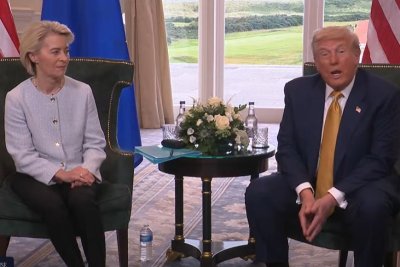July 27 (UPI) — President Donald Trump on Sunday announced 15% tariffs on most goods from the European Union, down from the threatened 30%, as part of a trade agreement with the 27-nation bloc.
Trump announced the deal at his Turnberry Isle Country Club in Scotland after his public session with European Commission President Ursula von der Leyen. Trump said the EU won’t impose new tariffs on U.S. imports.
During the meeting with the media, both leaders said the chance of a deal was 50-50.
“You’re known as a tough negotiator and dealmaker,” von der Leyen told Trump, with reporters on hand.
https://www.youtube.com/watch?v=k2w3imNVMSM
Leyen said the agreement “will bring stability. It will bring predictability. That’s very important for our businesses on both sides of the Atlantic.”
Trump said the deal was “satisfactory to both sides” in a second press conference that followed their talks.
The EU is the largest U.S. trading partner with $605 billion in goods yearly. The products are mainly drugs and pharmaceuticals, primarily from Ireland, as well as aircraft and heavy machinery, mainly from France and Germany.
The 50% tariffs on steel, like for most other nations, would remain, and more duties could be imposed for pharmaceutical products, as well as semiconductors. Trump has also threatened a 200% tariff on any drugs imported to the United States.
Trump said that in the deal, the EU has agreed to purchase $750 billion worth of U.S. energy and invest $600 billion into the United States more than they are currently investing, which wasn’t detailed. The EU is opening the bloc to trade for zero tariffs, and it will purchase “a vast amount” of U.S. military equipment, though the exact amount was yet to be determined, Trump said.
Trump also added that the deal will have a great impact on the U.S. car industry, noting that few American vehicles had previously been sold on the continent.
“So, I just want to congratulate you,” Trump said to von der Leyen. “I think it’s great that we made a deal today instead of playing games and maybe not making a deal at all.”
Von der Leyen added that the deal means that “basically, the European market is open.”
“It’s a good deal. It’s a huge deal. It was tough negotiations. I knew it at the beginning and it was indeed very tough, but we came to a good conclusion for both sides.”
On April 2, he said he would impose a 20% duty against the EU, with most trading nations imposed a baseline of 10%. He paused the retaliatory tariffs on April 9 for 90 days.
In a letter to EU nations on July 12, the U.S. president threatened 30% retaliatory tariffs to take effect on Friday.
“Imposing 30% tariffs on EU exports would disrupt essential transatlantic supply chains, to the detriment of businesses, consumers and patients on both sides of the Atlantic,” von der Leyen said after Trump’s letter.
Letters to other nations, including Brazil, have threatened tariffs as high as 50%.
The Trump administration has been negotiating with other nations, including reaching deals with China (30%), Japan (15%), Indonesia (19%) and Vietnam (20%). Britain, which is not part of the European Union, has a reduction in some tariffs of 10% on up to 100,000 vehicles and 25% on steel and aluminum.
Last year, the average U.S. tariff on imports from the EU was 1.2%, according to Capital Economics’ chief Europe economist.
The deal with the European Union is part of a broader trade agreement. The EU had a $58.7 billion overall trade surplus with the United States in 2024. For goods, it was $168.6 billion but the deficit was $126 billion in services trade.
In 2024, the bloc bought nearly $400 billion in goods.
Michael Brown, a senior research strategist at British-based Pepperstone brokerage, told The New York Times that U.S. defense companies likely will emerge as winners from the deal.
